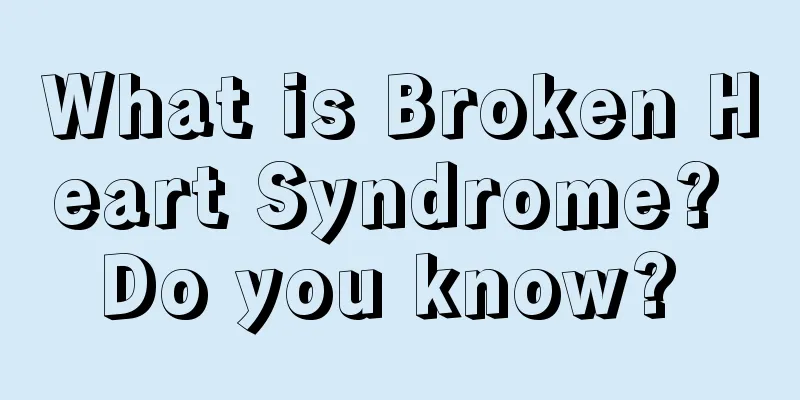What is Broken Heart Syndrome? Do you know?

|
Broken heart syndrome is a condition that people are very familiar with, but few people have a deep understanding of it. It is usually a symptom that occurs after people are exposed to strong stimulation. Its symptoms are similar to those of heart disease and myocardial infarction. Sadness, tension, anxiety and other emotions in daily life can lead to the occurrence of broken heart syndrome, so people need to learn to control their emotions after understanding it. Otherwise, this disease can cause severe chest pain and difficulty breathing when it is serious, seriously endangering the health of the body. For the sake of one's own health, it is very necessary to understand this disease, and the most important thing is to learn to control emotions. 1. Broken Heart Syndrome It refers to the symptoms similar to heart disease that people show after being exposed to multiple strong emotional stimulations. The latest research shows that disharmony in a couple's relationship can greatly increase the risk of heart disease. "Broken love is heartbreaking", "How to mend a broken heart", these lyrics now have biological verification. Science has discovered that when people, especially women, suffer severe emotional trauma (such as broken love, divorce, loss of loved ones), their hearts may become deformed or even broken. The latest research by American scientists found that "heartbreak" can cause chest pain, shortness of breath, and nervousness. "Heartbreak" is one of the oldest metaphors for the grieving. When describing the feeling of losing a loved one or a broken heart, people often use the expression “heartbroken”. Today, "heartbreak" is no longer a word frequently used by poets and philosophers, but has become the scientific name of a disease. 2. What is Broken Heart Syndrome It is called "stress cardiomyopathy" in medicine because most patients have suffered severe mental or physical stimulation before the onset of the disease. The disease was first discovered in Japan in 1990. The cause of the disease is that due to shock or severe emotional blow, the emotions fluctuate too much, the sympathetic nerves are overexcited, and the adrenaline level increases rapidly (the adrenaline level is 30 times higher than normal, and even 4 to 5 times higher than during myocardial infarction). Adrenaline and other chemicals will affect the normal activity of the myocardial muscles, or cause the capillaries to contract, causing the upper part of the heart to suddenly contract (the spherical shape of the apex of the heart changes), and the heart's beating ability suddenly weakens, causing symptoms similar to a heart attack: severe chest pain or difficulty breathing. The clinical manifestations are very similar to those of myocardial infarction, but it is purely a condition of the myocardium and has nothing to do with arterial infarction. Therefore, it must be distinguished from acute myocardial infarction. The report said: "It is entirely possible that a broken heart can cause a heart attack. When a person's emotions fluctuate too much, even a healthy person may suddenly become ill." Grief triggers broken heart syndrome Modern medicine has long proven that human spirit and thinking are only controlled by the brain and have no direct connection with the heart. But is there any connection between the heart and the human psychology? Studies have shown that the impact of psychological factors on "broken heart syndrome" is objectively real. The "Seven Emotions" (joy, anger, worry, thought, sadness, fear, and shock) mentioned in ancient Chinese medical books are seven normal emotional reactions. If the emotional reaction is too strong or persistent due to sudden, intense or long-term mental stimulation, the seven emotions will be excessive, affecting the function of the internal organs, disrupting the qi and blood regulation function and causing illness. In modern society, we have seen a significant increase in diseases related to psychosocial factors. Many scholars have proposed that the medical model should develop from a biomedical model to a bio-psycho-social medical model. Physical illness caused by psychological factors is called psychosomatic disease. The "broken heart syndrome" we are discussing here is a typical psychosomatic disease. The inevitable sadness in life Each of us will suffer many unavoidable sorrows in our lives, such as the death or divorce of parents, siblings, spouse, children, leaving your favorite job or friends, losing your health, losing your pets, and even losing your dreams for the future, etc., which will bring sadness and grief to you and the people around you. There are three words for sadness in English: bereavement, grief and mourning, and their meanings are slightly different. Bereavement is a state of being depressed. Grief is the feeling of sadness, anger, and guilt that occurs when a person experiences the loss or deprivation of a loved one or thing. To be more precise, you would not be sad unless you had been deprived of or lost someone you loved. But not everyone expresses sadness when a loved one or thing is taken away or lost. Mourning refers to the public display of grief, and how it is expressed has a lot to do with society, culture, and customs. 3. Causes Most sad emotions are disturbing, such as fear, helplessness, anger, guilt, tension, anxiety, depression, and sadness. These sad emotions are accompanied by numbness, auditory hallucinations, visual hallucinations, fantasies, confusion, and dreams. Drinking alcohol or taking drugs like tranquilizers and trying to avoid feelings of anger and sadness are all unhealthy strategies that grieving people use to avoid pain. Help grieving people recognize that grieving emotions and behaviors are normal and encourage them to express them appropriately. Broken Heart Syndrome For some people, grief is a long-term pain that takes time to heal. For example, anniversaries, birthdays of the deceased, and special holidays can all trigger sadness in people. However, due to lack of knowledge in this regard, relatives and friends around the grieving person often expect the grieving person to resume normal life and routine as soon as possible, causing the grieving person to suppress their grief and turning normal typical acute grief into complex chronic grief, which in turn becomes one of the obstacles to healing. In life, everyone will have negative emotions of one kind or another. People who are good at controlling and regulating emotions can resolve and overcome them in time, thereby minimizing the stimulation and harm of negative emotions. "Don't show your emotions on your face." Forcibly suppressing the expression of emotions can cause great harm to people's physical health. Because changes in tone, facial expression, movements, secretion of tears, etc. can be controlled by will. Changes in heart activity, blood vessels, and sweat glands, and contractions of the intestines, stomach, and smooth muscles change with emotions, but are not controlled by people's subjective will. Those who appear to have their emotions under control are actually transferring their emotions more into their bodies, causing damage to their internal organs. Therefore, if negative emotions have already arisen, they should be discharged and vented through appropriate channels, and never kept in the heart. 4. Symptoms The occurrence of "broken heart syndrome" is related to a person's personality, which is a complex psychological factor. American scholars were the first to divide people's personalities into Type A and Type B. Type A personality is characterized by impatience, impulsiveness, lack of patience, a strong sense of urgency, and competitiveness; Type B personality is characterized by calmness, patience, tolerance, non-competitiveness, and the ability to arrange one's work and rest schedule. Type A personalities are prone to "broken heart syndrome". |
<<: How to treat myocardial damage
>>: What to do with persistent sexual arousal syndrome
Recommend
Tips for breaking the pull ring of Eight Treasure Porridge
Most of the eight-treasure porridge we drink now ...
What to do if you can't urinate due to bladder cancer
There are two situations in which bladder cancer ...
Is breast cancer considered a family inheritance when it is over 60?
Breast cancer diagnosed at the age of 60 or older...
Finger tips are numb, causes of finger numbness
When numbness occurs in the fingertips, we should...
Common treatments for breast cancer 6 dietary methods for treating breast cancer
Breast cancer is a common disease in life, and th...
Is massage good for weight loss
Massage weight loss is a way of losing weight by ...
Will the chin be expanded after injection and removal surgery?
As cosmetic surgery techniques improve, more and ...
What are the precautions for preventing lung cancer? Here are six tips to effectively prevent lung cancer
What are the precautions for preventing lung canc...
Diet therapy for breast cancer with blood circulation and detoxification effects
Breast cancer patients may experience symptoms su...
How to massage your legs to relieve fatigue
If we walk for too long or exercise too intensely...
What's wrong with the wrinkles on the whites of my eyes
With the development of information networks, we ...
How long can a 75-year-old live with early symptoms of lung cancer
If lung cancer symptoms are detected early and tr...
What are the instructions for pregnancy test sticks?
Nowadays, people have more and more complete cont...
Melasma can be easily removed by using Duibai
Melasma is patches of hyperpigmentation on the sk...
Steps to burn the tooth nerve
Toothache is not a serious disease, but many peop...









